The Martinshof Story : 1936 - 1983
Page |
Next ||
1 |
2 |
3 |
4 |
5 |
6 |
7 |
8 |
9 |
10 |
11 |
12 |
13 |
14 |
15 |
16 |
? |
Reunion in 2010
A Philosophy of Happiness - Life Awareness - Memories from Spain
Next -
Top -
Photos -
Michael's Blog -
Jazclass
1. Before it all began : 1930s
 It all started because my father Johannes Theodorus Furstner (first name "Jan" for short) was not good in languages at school. In the Netherlands (right up until the 1970s) learning the three foreign languages, German, French and English was compulsory to pass your final High school exam. Over the years this has been a major stumbling block in their studies for many intelligent students and my father was one of them.
It all started because my father Johannes Theodorus Furstner (first name "Jan" for short) was not good in languages at school. In the Netherlands (right up until the 1970s) learning the three foreign languages, German, French and English was compulsory to pass your final High school exam. Over the years this has been a major stumbling block in their studies for many intelligent students and my father was one of them.
To rectify this shortcoming my grandfather Johannes Martinus Furstner sent my Dad overseas to learn those languages in their natural environment. So my Dad first lived and worked two years in London, followed by another two years in Paris. After that he went to Germany. Here, in the small picturesque Ost Sea town of Wismar, is where he met and fell in love with Else Johanna Erna Martha Hicken (first name Else).
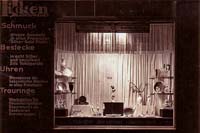 Else's father (my future German Grandfather) Claus Hicken was a qualified watchmaker and jeweler with a flourishing jewelry shop in which Else was a qualified and very experienced assistant behind the counter.
Else's father (my future German Grandfather) Claus Hicken was a qualified watchmaker and jeweler with a flourishing jewelry shop in which Else was a qualified and very experienced assistant behind the counter.
My father (like many other Furstners including myself) had a healthy aversion of working for others. So when my father and mother decided to get married they started to look around for their own business, and naturally their first choice was going to be a Jewelry business.
Next -
Previous -
Top -
Photos -
Michael's Blog -
Jazclass Links
2. Macking & Van Eldink (Hof leverancier) : 1936-1945
 Due to the sudden death of my Grandfather Johannes Martinus my parents' wedding was postponed for a year, but eventually took place in Wismar in 1936.
Due to the sudden death of my Grandfather Johannes Martinus my parents' wedding was postponed for a year, but eventually took place in Wismar in 1936.
After their honeymoon in Monte Carlo (where I was conceived) they headed for the small but ancient city of Zutphen, (a trading town on the river IJssel since 400 AD) where they took over the jewelry shop in the Beukerstraat of Macking & van Eldink, which were a Hof leverancier (Supplier) to the Dutch Royal family.
 The shop, jewelry workshop and a large showroom were located on the ground floor of the three story building. We lived in the upper two stories. There was also a sizable garden behind the house, largely covered with grass and containing a sand pit in which I spent much of my time after having entered the world in the master bedroom on the second floor.
The shop, jewelry workshop and a large showroom were located on the ground floor of the three story building. We lived in the upper two stories. There was also a sizable garden behind the house, largely covered with grass and containing a sand pit in which I spent much of my time after having entered the world in the master bedroom on the second floor.
One of the very first things I (Johannes Martinus Michael, first name Michael) remember of my life at age 2 or 3 is this most impressive silver knight, which always stood on the right hand corner (from the customer's viewpoint) of the shop's main glass topped display counter.
This knight was never sold. In 1945 my father took it home to Martinshof for safe keeping with several other items and buried it in a hole in our garden.
Unknowingly my grandmother, during his absence, had a chicken pen erected on the very spot, so that when my father returned in 1948 from the concentration camp we all had a huge laugh, shifted the pen and dug up the booty again. Because I had always been so fond of it my parents gave the knight to me as a Christmas present one year. I still have it, although now in safekeeping at my daughter Babette's.
Next -
Previous -
Top -
Photos -
Michael's Blog -
Jazclass Links
3. Exhibitions at the Beukerstraat
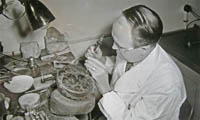 Two doorways led from the rear of the shop, one on either side, to the back of the house. The left doorway opened to a corridor which provided access to a staircase ascending to the upper floors, to the ground floor jewelry workshop, and at its end to a storage room and door to the rear garden. As soon as I was able to walk I commuted every day frequently between my sandpit in the garden and the workshop watching Eweg the goldsmith plying his craft and it was then and there that we started our lifelong friendship.
Two doorways led from the rear of the shop, one on either side, to the back of the house. The left doorway opened to a corridor which provided access to a staircase ascending to the upper floors, to the ground floor jewelry workshop, and at its end to a storage room and door to the rear garden. As soon as I was able to walk I commuted every day frequently between my sandpit in the garden and the workshop watching Eweg the goldsmith plying his craft and it was then and there that we started our lifelong friendship.
The doorway on the right of the shop, always open, led to a long narrow showroom behind the shop in which my parents held continuous exhibitions. The items on display included paintings, Leerdam glass, and terracotta statuettes and relief plaques. Some of the terracottas where creations of the sculptor Karasso.
In time many of these exhibits ended up in our own home Martinshof. After my parent's death they were distributed amongst us children and are still in our possession.
Besides Eweg, the goldsmith and designer Lily Prins (later Lily
Rimathé-Prins) also contributed to the shop in those early years. My parents employed two young lady shop assistants to help in the shop. One of them was Annie Martinus (full name Johanna Gardina Martinus), later to become Annie Dumbar, who remained a lifelong friend of the family. Mies was the other assistant.

Next -
Previous -
Top -
Photos -
Michael's Blog -
Jazclass Links
4. The War years at the Beukerstraat
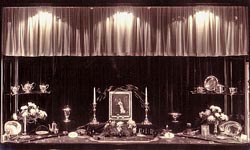 My parents quickly established and excellent name for their business with all the top end of town regular clients of their shop in the Beukerstraat. But all this changed overnight when Hitler invaded Poland in 1939. German nationals, "moffen" (Dutch derogatory term *) instantly became society's outcasts.
My parents quickly established and excellent name for their business with all the top end of town regular clients of their shop in the Beukerstraat. But all this changed overnight when Hitler invaded Poland in 1939. German nationals, "moffen" (Dutch derogatory term *) instantly became society's outcasts.
My mother too was no longer acceptable. Some clients had the grace to tell my parents they could no longer be seen in their shop, most others just stayed away. Bricks were thrown through the shop window on several occasions and my father was asked to his face, by other shop keepers in the street, which side he was on, that of that "moffen vrouw" of his or not.
Thus provoked my father, an idealist, romantic and totally loyal to his wife, had only one resounding answer : he immediately joined the Dutch Nazi party (NSB, Nationaal Socialistische Bond).
 For Annie too, one of the two shop assistants, a difficult and decisive moment had arrived. Her parents no longer wanted her to work in our shop. But she defied them, remaining loyal to my parents instead. As this situation became intolerable Annie left her parental home and started to live on her own.
For Annie too, one of the two shop assistants, a difficult and decisive moment had arrived. Her parents no longer wanted her to work in our shop. But she defied them, remaining loyal to my parents instead. As this situation became intolerable Annie left her parental home and started to live on her own.
This was not at all a political move (showing preference to the German cause), but a purely emotional one : Annie simply believed in my parents and their creative and idealistic approach to their business and life in general.
Note
A mof ("muff") has been a Dutch derogatory nickname for a German since the late 16th Century. It indicated someone with a "loud mouth".
Next -
Previous -
Top -
Photos -
Michael's Blog -
Jazclass Links
5. The Coehoornsingel
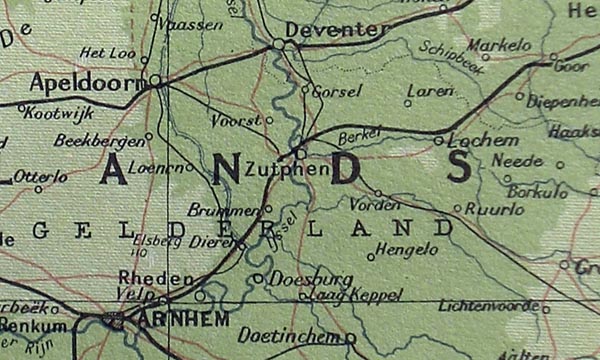 With the hostile and potentially dangerous situation which had developed, my parents moved their living quarters away from the Beukerstraat shop and rented a house on the Coehoornsingel away from the town's center and close to the small river the Berkel. It was here that my sister Wivica was born on May 4, 1940. With the hostile and potentially dangerous situation which had developed, my parents moved their living quarters away from the Beukerstraat shop and rented a house on the Coehoornsingel away from the town's center and close to the small river the Berkel. It was here that my sister Wivica was born on May 4, 1940.
The only thing I liked in the Coehoornsingel was a conifer tree, its branches reaching down to the ground, which stood in the center of a grassy hollow almost opposite our house, and part of a small park along the Berkel. I loved climbing into this tree. For the rest I found life here terrible and indeed frightening as (growing up into my 4th and 5th year) I became increasingly aware of the menacing mood of war. I had to go to a kindergarten which I hated, but was spared going there often as I got pneumonia three times in quick succession, each time ending up with a stint in the nearby hospital.
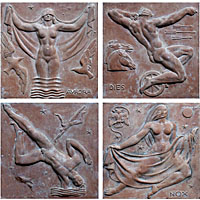 What happened with the living quarters above our shop at the Beukerstraat I am not sure, but vaguely remember that it remained unoccupied for the rest of the war.
What happened with the living quarters above our shop at the Beukerstraat I am not sure, but vaguely remember that it remained unoccupied for the rest of the war.
My mother, who had initially been the experienced and qualified one to run the shop, now reduced her duties considerably I believe (if not at all), as she had to look after two young children living away from the business.
My father by this time had completed a course with the Goldsmith School in Schoonhoven and obtained his qualification as a professional jeweler.
I am not sure how the Jewelry shop went during these years, it was probably just ticking over, but of course nowhere near its great prewar success.
Comments -
Next -
Previous -
Top -
Photos -
Michael's Blog -
Jazclass Links
Copyright © 2009 Michael Furstner
|


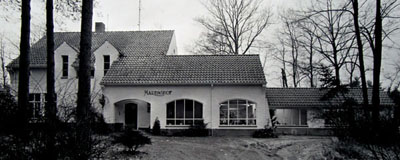







 For Annie too, one of the two shop assistants, a difficult and decisive moment had arrived. Her parents no longer wanted her to work in our shop. But she defied them, remaining loyal to my parents instead. As this situation became intolerable Annie left her parental home and started to live on her own.
For Annie too, one of the two shop assistants, a difficult and decisive moment had arrived. Her parents no longer wanted her to work in our shop. But she defied them, remaining loyal to my parents instead. As this situation became intolerable Annie left her parental home and started to live on her own. 
